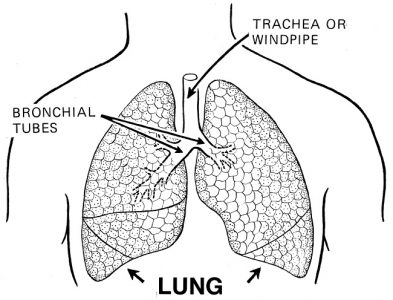The respiratory system is a vital organ system that allows for gas exchange. The lungs are the primary organ and contain numerous sacs known as alveoli, where gas exchange occurs. As the lungs expand, oxygen is brought into the lungs. Red blood cells pick up this oxygen via diffusion, while the waste gases such as carbon dioxide diffuse into the lungs to be expelled.
An illustration of the lungs is below. The trachea, or windpipe, leads to the bronchioles. The lungs are further divided into the alveoli.
Top 20 Fun Facts
- The left lung tends to be smaller than the right lung in people to accommodate for the heart, which is located on the left side of the body.
- Lungs can float on water. They are the only body organs that can float, largely related to the air that is contained within alveoli.
- If the lungs were unfolded and expanded out to their fullest size, they’d be roughly the size of a tennis court.
- When you breathe, 70 percent of waste is eliminated in the form of waste gases like carbon dioxide.
- Small air sacs within the lungs where gas exchange occurs are known as the alveoli. It is estimated that there are 300 to 500 million alveoli in the adult lungs.
- To aid in gas diffusion within the alveoli, these air sacs are lined with a layer of water.
- A surfactant is produced within the alveoli to reduce the surface tension present. This keeps the alveoli from collapsing when exhaling.
- The alveoli are surrounded by a network of blood vessels known as capillaries. The alveoli and capillaries are each only one cell thick, allowing for gas diffusion to occur.
- Red blood cells contain hemoglobin molecules that are responsible for picking up and carrying oxygen throughout the body.
- The lung capacity of an adult is approximately 4 to 6 liters of air. Males tend to have larger lung capacity than females. We only breathe in about 0.5 liters with each breath.
- A portion of the air you breathe never reaches the alveoli. It is referred to as dead air because it isn’t used in gas exchange.
- Even if you exhale really hard, a residual volume of 1 to 1.2 liters of air remains in your lungs.
- The diaphragm is a curved, thin muscle sheet under the lungs. It is used in breathing, flattening as it contracts and causing the lungs to expand.
- We don’t have to think about breathing because the medulla oblongata – a part of the brainstem – triggers us to inhale.
- The body is more likely to inhale because of high carbon dioxide levels in the blood rather than low levels of oxygen.
- The epiglottis covers the trachea when we swallow food. This helps to prevent swallowed materials from obstructing the airway.
- Hairlike protrusions from cells in the airway are known as cilia. They move mucus and trapped particles out of the airway. Smoking can damage these, causing mucus to build up.
- Sneezing can be triggered by irritations in the nasal passageways. Sneezing can also occur as a photic sneeze reflex, where the body sneezes when moving from a dark environment to a bright one.
- You lose water when you exhale. At rest, the body loses approximately 0.5 ounces of water. When exercising, your body can lose up to 2 ounces of water.
- Most people only breathe through one nostril at a time. Some people notice that which nostril being used switches at sunrise and sunset.

